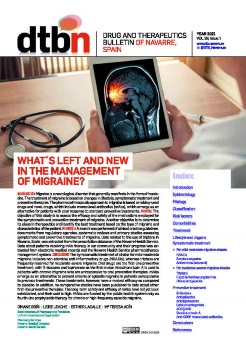What´s left and new in the management of migraine?
Bol Inf Farmacoter Navar. 2021;29(1):1-23
https://doi.org/10.54095/BITN20212901EN
The symptomatic treatment of choice for mild-moderate migraine includes non-steroidal anti-inflammatory drugs (NSAIDs), whereas triptans are frequently reserved for moderate-severe migraine. Oral drugs are the first-line preventive treatment, with s-blockers and topiramate as the first choice. Botulinum toxin A is used in patients with chronic migraine who are unresponsive to oral preventive therapies. mAbs emerge as an alternative to prevent chronic or episodic migraine in patients unresponsive to previous treatments. These treatments, however, have a modest efficacy as compared to placebo. In addition, no comparative studies have been published to date about other first-line preventive therapies. The long-term safety and efficacy of mAbs have not yet been established, and their cost is high. MAbs are funded by the public health system only as fourth-line prophylactic therapy for chronic or high-frequency episodic migraine.
Authors:
- Oihane Goñi. Subdirectorate of Pharmacy and Provisions. Navarre Health Service
- Leire Leache. Unit of Innovation and Organization. Navarre Health Service
-Esther Lacalle. Pharmacy Services. Navarre Hospital Complex. Navarre Health Service
- María Teresa Acín. Subdirectorate of Pharmacy and Provisions. Navarre Health Service


